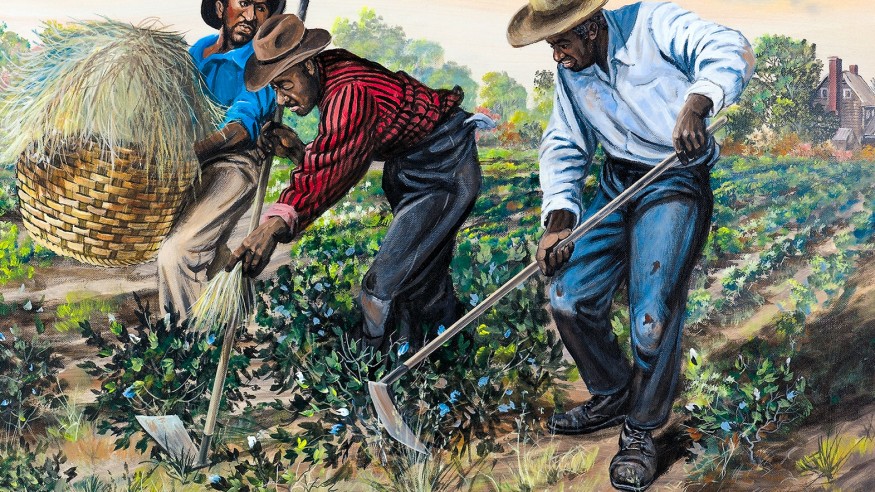
Ohio Wesleyan to Exhibit ‘Confederate Currency: The Color of Money’
This acrylic painting by John W. Jones, titled ‘Slaves Hoeing Cotton,’ was inspired by an image engraved on Civil War-era currency. Prints of 30 paintings created by Jones for his ‘Confederate Currency: The Color of Money’ project will be on display from Jan. 14 through Feb. 25 at Ohio Wesleyan University. Jones will speak on campus Feb. 18. (Image courtesy of John W. Jones)
Artist John W. Jones created the painting above based on this Confederate States of America currency.
DELAWARE, Ohio – Many of the images were so small that John W. Jones needed a magnifying glass to make them out. But what he found – and what he did as a result – continues to enlarge our understanding of American history.
Jones was working as a graphic artist when he was asked to enlarge a Confederate bank note for a customer. “I found myself looking at a picture of slaves picking cotton,” Jones says in his artist statement. “Intrigued and excited, I started researching and documenting the use of slaves on Confederate and Southern states money. I was astonished by the widespread use of slaves on these currencies, and even more shocked by the absence of this information in any history books.”
John W. Jones
Jones then began to imagine the lives of the African Americans depicted on the currency and later to recreate the small scenes with new detail and vision. All told, he created 83 paintings for the “Confederate Currency: The Color of Money” project. Prints of 30 of those paintings, including copies of the currency that inspired him, will be exhibited between Jan. 14 and Feb. 25 at Ohio Wesleyan University’s Gallery 2001. Jones also will visit campus Feb. 18 to discuss his groundbreaking artwork.
“When I paint these slave vignettes,” Jones states, “I see the strong and indomitable character of the slaves, the will to survive and carry on the qualities they brought with them from Africa in the form of music, religion, storytelling, art, architecture, agriculture, and culinary traditions. The paintings empower the slaves by giving them a voice that asks us not to reflect on them as the objects in the monochrome engravings on the currency, but rather, to join with them to confront the meaning of a system, past in one sense, painfully persistent in others, which enslaved them.”
Ohio Wesleyan’s Gallery 2001 is located inside Beeghly Library, 43 Rowland Ave., Delaware. Gallery hours coincide with library hours, which are 8 a.m. to 2 p.m. Monday through Thursday, 8 a.m. to 5 p.m. Friday, 10 a.m. to 5 p.m. Saturday, and 1 p.m. to 2 a.m. Sunday.
On Feb. 18, Jones will speak at 7 p.m. in the Bayley Room on the second floor of Beeghly Library. A public reception will follow in the first-floor gallery. The Ohio Wesleyan exhibit is sponsored by the university’s Office of Multicultural Student Affairs, Department of Fine Arts, and Richard M. Ross Art Museum.
Learn more about Jones’ paintings and see examples of his work at www.colorsofmoney.com. Learn more about the art exhibitions in Ohio Wesleyan’s galleries at https://www.owu.edu/about/offices-services/richard-m-ross-art-museum/.
Founded in 1842, Ohio Wesleyan University is one of the nation’s premier liberal arts universities. Located in Delaware, Ohio, the private, coed university offers more than 90 undergraduate majors, sequences, and courses of study, and competes in 23 NCAA Division III varsity sports. Ohio Wesleyan combines a challenging, internationally focused curriculum with off-campus learning and leadership opportunities to connect classroom theory with real-world practice. OWU’s 1,850 students represent 42 states and 37 countries. Ohio Wesleyan is featured in the book “Colleges That Change Lives,” listed on the 2013 President’s Higher Education Community Service Honor Roll with Distinction, and included in the U.S. News & World Report and Princeton Review “best colleges” lists. Learn more at www.owu.edu.
